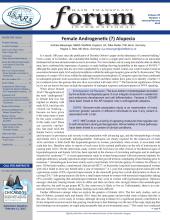
Our bread and butter patients are men diagnosed with pattern alopecia. Dr. Rodney Dawber states that while the exact prevalence of pattern alopecia is not accurately recorded, it probably approaches 100% in the Caucasoid races. Terminal follicles are gradually replaced by vellus follicles, then attrition of vellus hairs occurs, a process occurring from puberty until death. Fortunately for us, the diagnosis is straightforward in most men. (For the purposes of this column, we will leave the discussion on female androgenetic alopecia for another day.) In textbook classical form, men present with typical Hamilton or Norwood patterns with non-scarring changes of their scalp. They may or may not be affected with varying degrees of seborrheic dermatitis.
“Being able to handle a common problem with more insight and more efficiency, both in terms of coming to a diagnosis and in terms of developing a defined approach, I believe is of great importance to my colleagues.” —Vera H. Price, MD
Since the year 2000, we have heard a lot more concerns, presentations, scientific manuscripts, and hallway chatter that deal with the prevalence of lichen planopilaris (LPP) in hair transplantation. Was LLP present before or after the hair transplant? One such article reports 19 cases that developed following hair transplantation. It is almost as if cases of LPP, folliculitis, and cicatricial changes after transplantation seem to be on the rise. I suspect that increased awareness increases reporting in medical literature and better definitions of disease states are responsible and not an actual rise in occurrence. In my own practice, I have noticed a significant number of men with overt pattern baldness that come in for consultation displaying perifollicular erythema, subtle follicular hyperkeratosis, and questionable minute scarring along with physical findings that tend to fall outside the realm of androgenetic alopecia. These cases are often labeled by colleagues as early LPP or minimal or sub-clinical folliculitis. The typical patient who comes in is well informed on hair transplantation, appears to be a good candidate, is very knowledgeable of the procedure, is over age 30, and has pattern baldness with a Norwood II-V pattern. Upon exam, small punctate, white scars, and follicular erythema, with or without follicular keratosis, is often noted. Upon further inquiry, the patient has no idea what you are talking about when you question him further concerning scalp problems. He has never been treated for anything remotely related to a condition with the complicated sounding medical diagnosis of “lichen planopilaris.” Then that sinking apprehension sets in. Is this patient even a candidate for transplantation? Will I trigger LPP by operating on this patient? Am I worrying over nothing?
The above scenario is hardly a recent phenomenon among hair transplant surgeons. But what if up to 10% of all cases, typically diagnosed with common pattern alopecia, have these findings? Would we still be anxious to operate? What is the prevalence and what risk are we taking by transplanting these cases? I have recently seen reports that up to 8% of all patients with a diagnosis of androgenetic alopecia on initial inspection will later manifest clinical findings of LPP. Our own esteemed colleague Dr. Gholamali Abbasi is diligently working in this area of research.
This brings us to an interesting classification dilemma. Are these really cases of early LPP (which will come to haunt us later) or simply that 5, 8, 10% of all androgenetic alopecia manifests subtle changes consistent with classical LPP. These may be normal “variants” that do not represent any disease state.
In the end, this may be more than simply “splitting hairs” over nomenclature. We all want our patients to do well and no one wants to fight folliculitis or LLP for decades following a transplant. Biopsy in equivocal cases is often recommended, but is it really the answer? Biopsy involves both cost and delays. If the physician simply sees follicular erythema, follicular keratosis, and punctate scars, that is a pretty good indication there may be problems ahead. The pathology of early folliculitis, LPP, DLE, and folliculitis decalvans provides little insight into the ultimate clinical course of the patient. Until this mess is sorted out, we should raise up our antennas to be ever vigilant into those cases that display early subtle physical finding of LPP. We may have yet to fully appreciate all the subtleties of common baldness.
- Copyright © 2015 by The International Society of Hair Restoration Surgery






